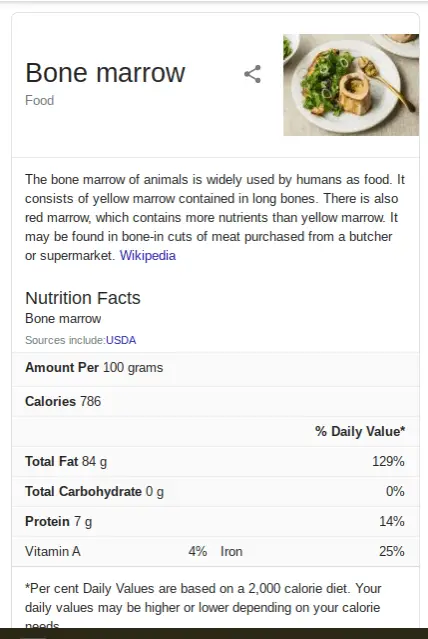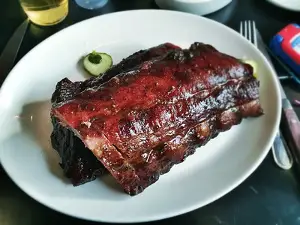
chew on a bone everyday! ¹
Have you heard that marrow bones are the gold standard of dog bones?
Are you done with your rawhide bones and your Kongs?
But before you go all in on marrow bones, you want to find out more.
For instance, how many marrow bones can a dog have?
Before I answer that question specifically, I want to tell you what exactly I mean by marrow bones.
After all, there seems to be some confusion around them.
So let’s jump straight in…
What are marrow bones?
Although all animal bones have marrow in them to a greater or lesser extent, to dog owners marrow bones specifically refer to the larger leg bones of animals such a cow or a pig.
Marrow bones are round with a hard outer layer of bone and a soft “paste” inside which is the marrow.
And when I am talking about marrow bones, I am talking about the ones that look as if they are fresh from a butcher.
And fresh from the animal itself.
Don’t mistake authentic marrow bones from some of the “filled” bones (which are marrow bones which have been cleaned and then filled with a cooked paste of ingredients.
Neither should you be tempted by cooked marrow bones- although they might look more appealing to dog owners, like other cooked bones they are not suitable for dogs.
Marrow bones need to be fresh and raw.
The only cooking that a dog owner should contemplate with a marrow bone is when they make a marrow bone broth.
OK, that description was far more detailed than I intended!
Let’s move on and see if your dog can can overdose on these bones? I mean, just how many should they have?
How many marrow bones can a dog have?
There is no easy answer to this question, I’m afraid.
It depends on the size of your dog and on the size of the marrow bones, which come in almost as many differences sizes as dogs.
Why is my dog vomiting after eating a marrow bone?
Most marrow bones that are available tend to be four or five inches long because the bone has been cut up into smaller sections.
But if the marrow bone has not been cut up then they can come in longer sections.
To play it safe, if you have a small dog then just limit them to one, five or six inch marrow bone a week.
If you have a larger dog, then you could up the limit to two of these bones a week.
To work out why I am putting these limits on the number of bones, in the next section I will look at some of the hazards that marrow bones present to dogs.
3 cons of bone marrows
There are three possible concerns that marrow bones present to a dog owner that other sorts of bones don’t.
- Marrow bones might break a dog’s teeth
- Marrow bones might get stuck on dog’s teeth
- Marrow has a high fat content
Marrow bones are tough
As far as animal bones go, marrow bones are thicker and much harder than most bones. This is because they tend to be weight bearing bones from larger animals- the leg bones of cows for instance.
Bones that are harder or more dense can be dangerous because they will be much tougher for your dog to chew.
This is fine as long as your dog doesn’t have weak teeth or your dog is an aggressive chewer.
If your dog falls into either of these two camps then marrow bones might be the sort of bones that you should avoid giving to your dog or if you do give your dog one of these bones then you should consider closely monitoring them as they chew.
Marrow bones might get stuck
If the thought of your dog’s teeth being broken or chipped by chewing on a marrow bone wasn’t enough of a fright, then another scary consideration would be a marrow bone getting stuck on your dog’s tooth.
Marrow bones might get stuck on teeth for the same reason that they break them- because as bones go they are very thick and tough.
And it is important to say that it would be an incredibly rare for a marrow bone to get stuck on one of your dog’s teeth.
But if it happens, it can be a very traumatic event. Firstly because the dog will be very distressed and anxious but also because if the bone gets stuck, it can be very tricky to prise loose without breaking a tooth.
And trying to do some with a dog that will be very upset makes it even more of a challenge.
Bone marrow has a very high fat content

Supposing that your dog has managed to get through the bone and to the marrow in the centre, the bone marrow has lots of wonderful nutrients in it but is does have a significant dark side- it is about 85% fat!
Dogs, like humans need fat in their diet. Too much and too little is dangerous.
Too much fat content in your dog’s diet can lead to pancreatitis although interestingly, not heart disease.
And too much fat can upset your dog’s stomachs and lead to diarrhoea.
On the plus side, significant nutrients that bone marrow contains include:
- Phosphorous
- Iron
- Vitamin A
- Niacin
So just keep an eye on it.
Marrow bones also come with some disadvantages that are common to all bones.
I will quickly mention two.
Cooked bones
Dogs should never be given cooked bones- marrow or otherwise.
Cooked bones are too brittle and splinter in dangerous ways because they splinter with sharp edges which can get stuck in or cut the sides of the throat or the stomach.
Food possessiveness
If your dog has a hint of possessive and aggressive behaviour in its character, feeding bones will worsen these behaviours.
I am not saying don’t feed bones to aggressive dogs but you do need to be very careful in how you do it.
Make sure that the dog has plenty of space and is left undisturbed for as long as you want it to have the bone and then make sure that you can get the bone back from the dog!
Enough of the dangers or disadvantages of bone marrows, let’s be more positive and look at some of the advantages that marrow bones offer.
Advantages of marrow bones
Marrow bones are a popular choice of bone for dog owners for a number of reasons.
And they offer a few benefits that other types of bone, don’t.
Firstly, as bones go, they are fairly large and bulky any by this I mean, how wide and thick that they are.
This means that they tend to last much longer than other bones that you might give your dog.
Secondly marrow bones combine a hard and soft texture- the outer bone which is rock hard compared to the soft marrow in the centre- it is almost like a sweet for dogs.
Because of these different textures, dogs should be more satisfied as they will combine different gnawing techniques with licking out the marrow.
Thirdly, the innards of these bones can be filled other foods once the marrow have gone.
In more general terms, raw bones of any sort offer a host of benefits for dogs.
These include:
- natural, preservative free.
- Great source of vitamins and minerals
- Mental stimulation of chewing
- Stops other destructive behaviours
It can also act like a brush and floss for the dog’s teeth, so let’s talk about it too.
Bone marrow can be good and bad for your dog’s dental health

your dog ²
Bone marrow helps to ensure your dog to be tartar-free and reduced gum disease. Tartar formation could result in infections and contribute to several health problems.
The activity also helps to stimulate the production of saliva enzymes, which could help to prevent plaque to buildup and keep your dog’s teeth clean.
However, your dog may suffer from broken or cracked teeth if you gave a dry bone as it becomes harder and brittle once it gets drier. Dogs who are new to bone consumption or ones that chew their bones aggressively are likely the ones who might suffer from this. And if the bones got stuck on their lower jaws, it could easily break your dog’s tooth.
While we appreciate the benefits our dog can get from chewing bone marrows, we still need to know how much they can only have.
What are the best types of bones for recreational chewing?
Technically, most raw bones that are not uncooked and don’t have preservatives should be the one that you are looking for but the best type of bones that are soft enough to chew, eat, and digest are:
- Raw chicken
- Turkey
- Lamb flaps
- Beef bones
- Oxtail
For small dogs, you can give them organic chicken necks, high-welfare duck feet and chicken wings, while for medium-sized dogs are chicken thighs, chicken carcass and turkey wings. Lastly, for large dogs, it is recommended to give them lamb ribs, lamb neckpieces, chicken and duck carcass and fish heads.
How about other alternatives like grass-fed bone marrow? If you don’t know about it, then let us explain.
What is grass-fed bone marrow?
Grass-fed bone marrow is a whole bone extract that comes from an animal that was either 100% grass-fed or grass-fed and finished with grains and without the use of pesticides, hormones or antibiotics.
It is more nutritious and healthier than conventional beef as we know that grass is high in omega-3, which can aid in brain development for the dogs. So this is also a safe choice for dogs.
Finally, let’s talk about where we can buy marrow bones for dogs?
Where to buy marrow bones that are safe for dogs?
So after talking about this and that about marrow bones, we can finally look at a very important question.
Where is the best place to get your marrow bones from?
Your best bet should be your local butcher’s shop or meat market.
This is where you should find the freshest marrow bones and the cheapest.
After all, there are no delivery costs!
If you draw a blank from your local butcher then your next choice should be the fresh meat counter at your local supermarket.
You may be amazed that I haven’t yet mentioned your local pet shops and the reason is that in my experience local pet shops sell every type of marrow bones apart from the ones you want.
You will see filled marrow bones (which are the incredibly white bones that have been sterilised and filled with meat substitutes) or the cooked and filled marrow bones (which are yellow in color and also filled with a meat substitute paste.)
If you are lucky, your local shop may have a small selection of frozen raw marrow bones and these are the ones that you want.
And if all else fails or your best and first choice is always the Internet then in the next section I will take a look at the top sites on the Internet for getting your dog some marrow bones
There are a few websites that you can check that sell and deliver marrow bones in the U.S.
What are the big websites in the U.S. that sell and deliver marrow bones?
You can check these following websites in the U.S. for marrow bones as well as grass-fed bone marrows:
- Amazon.com – Prices for the top selected bone marrows products could go as low as $8.83 and can go as high as $24.99.
- rawpawspetfood.com – Approximate cost: $28.99 – $159.99
- onlynaturalpet.com – Approximate cost: $4.99 – $39.56
- chewy.com – Approximate cost: $2.30 – $17.99
- jackandpup.com – Approximate cost: $11.95 – $ 19.95
- bestbullysticks.com – Approximate cost: $3.43 – $ 31.99
There are few more other websites but make sure to check the reviews and if they certified to sell bone marrows.
However, if you are living in the U.K., you may want to consider checking these websites.
So, what are these big websites in the U.K. that sell and deliver marrow bones too?
Here are the top websites you can use to search for bone marrows for your dog:
- amazon.co.uk – Prices could go as low as £4.91 and can go as high as £15.99
- nutriment.co.uk – Approximate cost: £5.70 – £11.50
- naturesmenu.co.uk – Approximate cost: £1.25 – £2.69
Conclusion
Choosing whether to give your dog bone marrows is a matter of personal choice; however, it would be best to do some research and consult with your vet first to get some idea and guidance to help you determine which bones will be safe for your dog and which ones to avoid. Remember to feed your dogs with uncooked and raw bones only, and choose a suitable size for your dog. Moreover, make sure to monitor them and check if the bone is breaking into dangerously small pieces to prevent undesirable situations. Never leave your dog unattended, especially if they are aggressive chewers. So as long as you follow the safety guidelines, your dog should be able to enjoy them safely.
Photo Credits
¹ Photo by Adam Levine on Flickr
² Photo by Dicky Jiang on Unsplash
³
⁴
⁵
⁶
⁷
⁸
⁹





